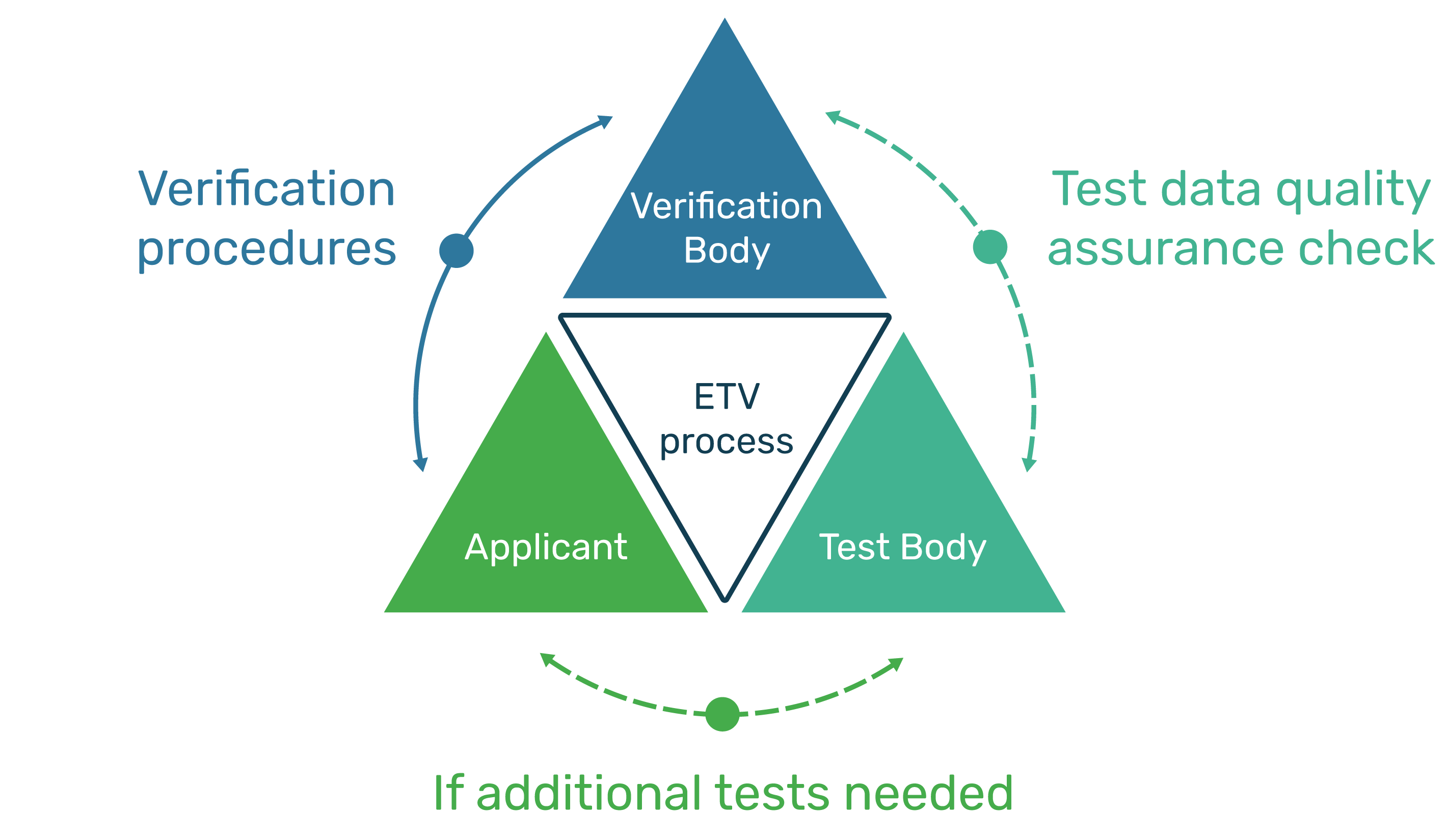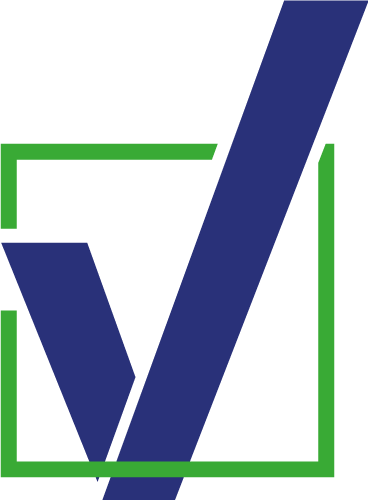Get to know ETV

ETV is carried out in 5 steps.
This short video will guide
you through the ETV process
To learn more about the ISO 14034 ETV scheme:
How to verify your green innovation?
Which technology is a good candidate for ETV?
ETV adresses environmental technologies that are:
- products, processes, services for industrial applications
- commercially-ready (early market stage -TRL min. 7) or already available on the market
- designed to result in reduced environmental impacts or to measure and monitor parameters representing environmental impacts, for example:
- technologies for water treatment, energy production or recovery, solutions for improving resource efficiency , biobased materials, remanufacturing processes
- water monitoring equipment, samplers, sensors, probes used for environmental measurements.
Find out how to verify a technology
To get more information about the ETV process and how it involves the applicant
Go to Guide for ETV Applicants
Check if you are ready to apply for ETV
Who may apply?
- Technology developer
- Technology manufacturer
- Legally authorised representative e.g. investor
Who verifies?
Verifications are carried out by Verification Bodies accredited as type A inspection bodies according to ISO 17020 Conformity assessment — Requirements for the operation of various types of bodies performing inspection to perform ETV compliant to ISO 14034.
Who tests?
To generate test data relevant to backup the performance claim to be verified, the applicant may:
- designate a Test Body accredited under ISO 17025 for methods within the relevant area of analysis
- use of a different Test Body, not accredited under ISO 17025 for methods within the relevant area of analysis subject to additional audit made by the Verification Body before going ahead with the testing
- perform the necessary tests inhouse. In this case, the test plans, all preparatory measures such as sampling and the tests themselves shall be prepared and implemented in agreement with and, if necessary, witnessed by an independent test body.
Learn more about ETV quality & impartiality
Where to?
Verify a technology
Advantages: learn how ETV provides a competitive edge

Increased confidence of buyers and users
ETV provides an independent and third-party validation of a technology’s performance based on ISO standardised process and ISO standardised quality and impartiality framework ETV. As a third-party scheme instils confidence in buyers and users who may be uncertain about the performance and environmental benefits of a technology. This increased confidence can lead to higher adoption rates and user satisfaction.

Credibility and trust
Offering a verified technology enhances the credibility and trustworthiness of the technology provider especially when the company is new and challenges competition from established market players.

Market differentiation
Having an ETV Statement of Verification sets a technology apart from competitors in the market. It serves as a tangible demonstration that the technology has been rigorously tested and verified, giving it a competitive edge.

Access to new markets
ETV can open doors to new markets, especially in regions or industries where there is a strong emphasis on environmental sustainability or when standards and regulations applicable to a given technology vary across jurisdictions. Many buyers, particularly in the public sector, prioritize technologies with proven performance that complies to the requirements of their market to the when making procurement decisions.

Regulatory compliance
ETV may help technology providers navigate regulatory requirements and administrative burden by ensuring regulatory or permitting bodies as well as buyers and users that their technologies meet or even exceed environmental standards. It may also help buyers and users understand how the technology will help them comply to legal regulations and standards when installed. This can streamline the approval process and reduce barriers to market entry.

Risk mitigation
Verification through ETV can help mitigate risks associated with market failure. Potential users are more likely to adopt and potential investors to finance technologies that have been independently validated, reducing thus their risks and uncertainties related to its performance, interoperability or environmental impact.

Facilitated financing and interest of investors
Technology providers whose technologies have been verified by ETV may find it easier to secure financing or attract investment. Investors and financial institutions often view verified technologies as lower-risk investments with potential for positive environmental and financial returns. It applies in particular in the context of ESG and the EU green taxonomy.

Stakeholder engagement
ETV can facilitate engagement with various stakeholders, including regulatory agencies, investors, actors in value chain and environmental organizations. It provides a standardized and transparent way to communicate the performance and resulting environmental benefits of a technology. It applies in particular to technologies that suffer from low public acceptance, raise concerns among regulatory or permitting bodies or address value chains and supply networks with highly restrictive environmental considerations.

Demonstration of long-term savings
Innovative environmental technologies are often perceived as more costly requiring high initial investments and high uncertainty of potential long-term savings . ETV can help demonstrate how the long term savings resulting from reduced environmental impacts are achieved.

Innovation recognition
ETV can be a recognition that a technology is innovative. It allow to prove how the novelty of a technology converts into its performance resulting in reduced environmental impacts.

Improved marketing opportunities
ETV provides a powerful marketing tool. Technology providers can leverage the verification in their promotional materials, advertising, and communication strategies to attract a wider audience.
How to implement ETV in an innovation project?
If your project aims at development of an early market stage environmental technology and includes a pilot or a demo installation, you may consider ETV to get a proof that your green innovation performs at the final stage of the project.
You may consider ETV as a part of a work package dedicated to environmental assessments or as a part of exploitation activities.
Some practical tips on how to plan and implement ETV in an innovation development project
TIME
ETV takes time: plan a minimum of 12 months to before project end to perform ETV, possibly engage with a verification body early in advance
BUDGET
Earmark appropriate budget for:
- engaging with a verification body,
- a project partner who will be the applicant
- technology testing
STAKEHOLDERS ENGAGEMENT
Plan stakeholders engagement activities:
- to get a clear understanding of the link between the performance of the developed technology and stakeholder needs and expectations
- to get a basis for development of testing protocols for performance testing and verification recognised by stakeholders
- to come out with a proposal of a market relevant claim
LEGAL FRAMEWORKS FOR TECHNOLOGY PERFORMANCE & APPLICATION
Get to know the legal frameworks for the technology performance and its use for the intended application:
- analyse the legal requirements and standards pertianing to the technology and the performance to be verifed
- analyse the upcomming regulations that the users of the technology will have to challenge
OPERATIONAL ENVIRONMENT FOR TECHNOLOGY PERFORMANCE
Plan and perform tests allowing to define the conditions, assumptions and constraints for the stable performance of the technology
ENVIRONMENTAL ADDED VALUE
Analyse and define the major differences in environmental impacts (positive and negatve) between the technology and existing alternatives from the life cycle perspective in order to demonstate how the innovation results in an environmental added value.
Check if you are ready
- $Self assessment tool
